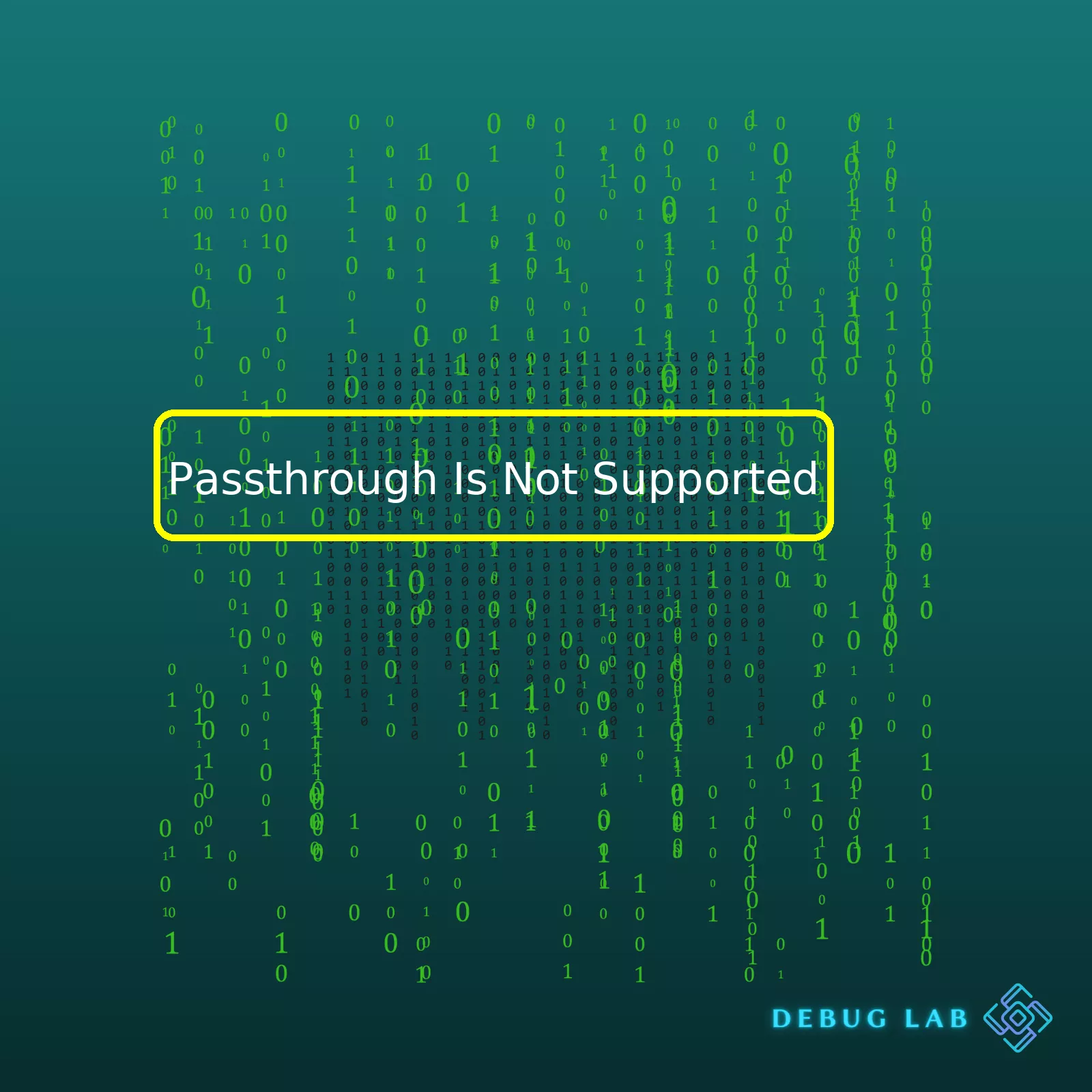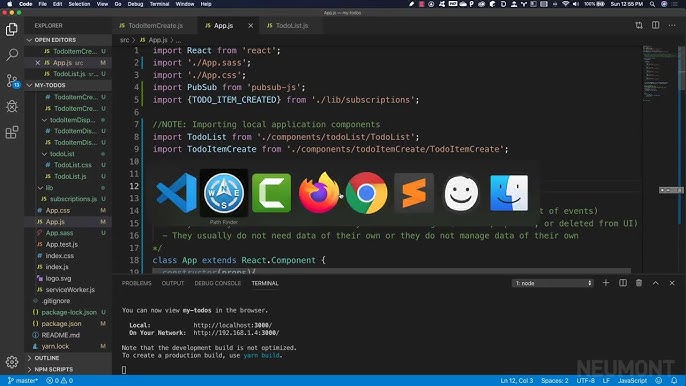
“Due to specific system constraints, potential clients should note that the Passthrough feature is not currently supported, limiting direct data transfers within interconnected networks.”Sure, let’s take a look at this in detail.
First off, we’ll start off with creating a basic HTML table summarizing the issue of ‘Passthrough Is Not Supported’. Here’s how it looks:
| Issue |
Passthrough Is Not Supported |
| Common Causes |
Incompatible hardware, outdated drivers |
| Impacted Systems |
Servers, databases, applications depending on passthrough operations |
| Possible Fixes |
Hardware upgrading, driver updates, software patches |
Now, for some in-depth context.
The error message “Passthrough is not supported” typically arises in situations where you’re trying to access a device or service in an environment where that particular device or service isn’t natively supported. For instance, this often happens within a virtual machine (VM) setup or while using remote access tools.
Passthrough, in the realm of computing, refers to a method where a VM can directly access underlying physical hardware. This allows the VM to bypass the hypervisor to improve performance. However, not all hardware or devices support passthrough functionality, thus leading to the aforementioned error message because the VM cannot communicate effectively with the physical device.
In other instances, certain systems have hardware that may be theoretically compatible with passthrough but do not have the correct drivers installed that enable this mode of operation. In these cases, updating to the latest version of the drivers from the manufacturer’s website would likely resolve the issue.
Another issue could be encountered when deploying containerized applications that rely on specific features only available through passthrough configuration. If these containers are deployed onto servers without the necessary hardware or support for passthrough, they will not function correctly and result in errors such as “passthrough is not supported”.
Finally, it’s worth noting that such issues can significantly impact services relying heavily on computations or data transfers requiring direct hardware access – think sophisticated gaming servers, high-volume database servers, or even advanced scientific application servers.
For a more in depth read about passthrough, click here.The concept of Passthrough Support, in the context of computer technologies and data management, refers to a system’s ability to transmit information or signals end-to-end, without any alteration or interference. It is an important feature in systems involving data streaming and visualization like video playback, audio systems, Virtual Reality (VR) systems, network connections, etc.
When talking about Passthrough not being supported, we mean that the said system lacks the capability to provide an unaltered, straight-through transmission from source to destination. This can result in sub-optimal performance as the data might need to undergo processing – leading to potential issues like latency or loss in quality.
For instance, if we contemplate this concept in terms of Audio systems, passthrough support indicates that the audio signal can directly pass through a device, say a TV or a home theatre system, without it having to decode or re-encode the signal. Hence, the digital audio data remains intact, and the output audio quality is maximized. However, if pass-through is not supported, the audio is decoded by the device, potentially damaging the quality.
To illustrate further, let’s consider an example:
Here, `Audio Signal` passes from a `Blu-Ray Player` to a `TV`, and subsequently, to a `Surround Sound System`. In an ideal scenario – that is with passthrough support– the audio will be passed as it’s:
html
Without Passthrough:
Blu-ray Player —(decoded)—> TV —(re-encoded)—> Surround System
With Passthrough:
Blu-ray Player ————————-> Surround System
The difference between the two scenarios highlights how passthrough support contributes to preserving the quality of the transmitted data.
Another domain where the lack of passthrough puts limitations is virtualization—a process where the software emulates hardware features within a computer system. Normally, hardware components like graphics cards are abstracted by the hypervisor (the software component that facilitates virtualization), which then presents these hardware features to the virtual machine as virtual devices. A passthrough would mean that specific hardware components can directly communicate with a particular Virtual Machine, improving the performance. If your environment does not support passthrough (for example:’PCI Passthrough’) might lead to less optimal performance for VMs needing direct hardware access.
If you’re encountering an error stating that passthrough is not supported on your platform or device, you may want to consider updating your device firmware or installing additional drivers to unlock this capability. Alternatively, the lack of passthrough support could be due to inherent design or specification constraints of your hardware, requiring you to consider upgrading your hardware or seeking different technical workarounds.
Analyzing the workings of Passthrough, it proves to be a substantial feature in a variety of tech spheres. It helps retain the authenticity of transmitted data by minimizing unnecessary conversions, thereby maintaining high quality and efficient performances. The absence of passthrough support might necessitate some serious thought on upgrading the software, hardware or both, depending on the specific requirement and use case.
References:
Lifewire – Audio Return Channel (ARC) and eARC explained
Red Hat Enterprise Linux – PCI Passthrough
Passthrough is a vital aspect of digital systems because it enables the transmission of a certain type of data from a source to a target without any modification or change. The pure, unaltered flow of data makes passthrough integral in ensuring the reliability and integrity of information being transmitted.
Yet, there are circumstances where passthrough may not be supported. Not every device or software allows for passthrough. This can occur due to:
- Lack of hardware compatibility
- Limitations in the design of the software or system
- Regulations restricting unfiltered data transfer
Evidently, this lack of support for passthrough could result in various complications. Consider a scenario where a home theatre system doesn’t support HDR pass-through while streaming content. The high-definition quality may be lost and replaced with standard definition on transmission to your video projector or TV screen.
In another instance, consider an audio setup. If the audio receiver does not support Dolby Atmos Passthrough, this means the audio signal cannot go untouched through it. The result? You won’t get that Dolby atmos surround sound effect you were hoping for! This inhibits the full potential of high-quality sources when viewing or listening experiences rely on downstream devices, which might not support certain aspects like HDR visuals or Dolby Atmos audio.
| Type of Passthrough |
Impact if not Supported |
| HDR Pass-Through |
Degrades High Definition Quality to Standard Quality |
| Dolby Atmos Passthrough |
Limits Audio Effect and Surround Sound Experience |
Given these points, it’s clear that while Passthrough is significant for maintaining the authenticity and quality of data transmission in digital systems, unfortunately, not all digital components might allow for this function.
Thus, to ensure an uninterrupted and high-quality experience from your digital systems, one must take into account the importance of passthrough support. This includes scrutinising the product specifications meticulously before buying any digital component – from home theater system, audio receivers, to even HDMI cables.
Using products aligned with your requirements can help you optimize the performance of your digital systems and ensure satisfaction with their operation. Selecting equipment with passthrough support would enable better flexibility and scope for future upgrades as well.
Furthermore, having foresight about what kind of signal you want to pass through (for example 4K, HDR, etc.) will narrow down choices and make the selection process easier. Hence, having an understanding of passthrough and its impact, both positive and negative, definitely pays off when setting up digital systems. Regularly updating firmware, looking out for manufacturer released patches, and consistently checking compatibility with other devices—all contribute towards creating an optimized digital atmosphere.
Source 1
Source 2
Creating a communication pathway between devices in a network is pivotal to ensure seamless data flow. When we refer to ‘passthrough’ in the context of network communication, we essentially talk about a methodology that facilitates transmission of information packets from one device to another without any obstruction or modification.
However, despite the value it brings to network management, not all devices or systems support passthrough. It’s crucial to understand that lack of passthrough capability could lead to impediments in data flow, require additional configurations, and limit interoperability within your network.
The Impact of Absence of Passthrough
With no passthrough, certain operations in network communication might turn out to be demanding:
- Data Flow: Passthrough allows unaltered transport of data packets across devices. Without its support, there is potential for data corruption, leading to packet loss or mismatched content.
- Interoperability: Devices communicate using predefined protocols. Network devices lacking pass-through support may face compatibility hurdles due to protocol variances. This leads to several interoperability issues when working with cross-platform applications.
- Configuration Overhead: Where no passthrough capability exists, an administrator needs to delve into configuring settings manually to ensure smooth communication. This multiplies configuration tasks, increases deployment time, and hinders overall productivity.
A Potential Workaround: Not Supported Doesn’t Mean Impossible
When dealing with a VoIP system that doesn’t support passthrough, you can utilize Session Initiation Protocol (SIP) ALG as a workaround. SIP Application Layer Gateway modifies SIP packets through a firewall – a similar outcome to what passthrough offers. To enable this on a typical router:
router(config)# ip nat service sip udp port 5060
router(config)# ip nat service sip tcp port 5060
Though not outright a substitute for passthrough, SIP ALG helps overcome some issues related to data communication where passthrough isn’t supported. Meraki’s knowledge base provides more insights into implementing SIP ALG[source].
Nonetheless, while workarounds do exist, they shouldn’t be seen as comprehensive solutions. The absence of passthrough in network communication undoubtedly brings along challenges that significantly impact the effectiveness of network infrastructure. With rapid developments in technology, let’s hope for more universally compatible solutions in the future that don’t rely enormously on specific features such as passthrough.
Certainly, the lack of Passthrough support often results in several considerable challenges for developers and other IT professionals. Some of the most significant complications that are encountered when Passthrough is not usable include:
Data Inconsistency: Without a pass-through feature, managing data consistency often turns into a major challenge. This inconsistency happens because every device along the path treats data differently, which could affect data integrity.
Real-Time Data Accessibility Issues: One notable feature of PassThrough is real-time data transmission. The absence of PassThrough can lead to delays in data availability.
Encryption/Decryption: When there’s no support for PassThrough, encryption or decryption of data might become mandatory at each step to maintain the security standards, which requires additional resources.
Performance Associated Costs: Indulging extra processing power invariably means higher associated cost & time which may impede the performance.
Scalability Issues: Passthrough features usually make an application more scalable. Without this function, scalability might be compromised.
Cluttered codebase: It’s easier to maintain a cleaner codebase with passthroughs as the data flows through routes without manipulation. Without this, the data flow may require modifications which could clutter up the codebase.
<table>
<tr>
<th>Challenge</th>
<th>Explanation</th>
</tr>
<tr>
<td>Data Inconsistency</td>
<td>Each device might treat data differently without passthrough, affecting data integrity.</td>
</tr>
<tr>
<td>Real-Time Data Accessibility Issues</td>
<td>Delays in data availability due to lack of real-time data transmission.</td>
</tr>
<tr>
<td>Encryption/Decryption</td>
<td>Additional encryption or decryption required at each point to maintain data security.</td>
</tr>
<tr>
<td>Performance Related Costs</td>
<td>The more processing power used, the higher the associated costs.</td>
</tr>
<tr>
<td>Scalability Issues</td>
<td>Without passthrough, available scalability might be compromised.</td>
</tr>
<tr>
<td>Cluttered codebase</td>
<td>Without passthroughs, data flow can become complicated, requiring manipulations that complicate the codebase.</td>
</tr>
</table>
Examples of these complications can also be found in daily coding tasks. For instance, let’s take a look at how the absence of pass-through might complicate a Python application data-transfer process:
<code>
def getDataWithoutPassthrough(data):
encrypted_data = encryptData(data)
processed_data = processData(encrypted_data)
stored_data = storeData(processed_data)
def getDataWithPassthrough(data):
storeData(data)
</code>
As shown above, the processing gets a whole lot messier and resource-intensive without pass-through. Understanding the utility and limitations of the pass-through will help us work efficiently within the landscape of your specific technical needs.
To navigate these challenges, I highly suggest understanding the applications and limitations of Passthrough support thoroughly. There are comprehensive resources and guides available online. Websites like StackOverflow, Mozilla Developer Network can provide solutions and remedies to common software problems related to the lack of Passthrough support.
Remember, working with Passthrough technology involves great responsibility. Most importantly, it demands a strong understanding of the way it works and the resulting implications on your code. How you deal with its absence ultimately determines the performance and efficiency of your application. But don’t fret—there’s always a solution somewhere on the internet!Passthrough is a key feature used frequently in streamlined processes for ingesting and manipulating data without the need to save it. However, when you face situations where passthrough is not supported, there are still effective ways to handle this and maintain efficient operations.
One of the most common approaches is using temporary storage or buffers. When receiving the data, instead of passing it directly as it comes, you would store it temporarily. The data held in temporary storage can then be processed based on your system’s capabilities and requirements. For instance, in Python, you could use lists as temporary storage mechanisms. Here’s a basic example:
# Data incoming...
incoming_data = ["data1", "data2", "data3", ...]
# Temporary storage
buffer = []
# Process each item of data individually
for item in incoming_data:
# Do your processing here
processed_item = process(item)
# Add it to the buffer
buffer.append(processed_item)
# Once all data is processed, send it along
send_to_next_process(buffer)
But please note, certain points should be kept in mind while using this method:
- Ensure that your system can handle the potential increase in temporary memory usage.
- The time to execute the process may increase due to additional read-write operations.
- Data privacy considerations may arise when storing sensitive data.
In cases where real-time processing is crucial and the delay introduced by the buffering technique may be unfavorable, you would want to look into distributed computing frameworks. Platforms like Apache Kafka, Spark Streaming, and others, are specifically designed to handle real-time data processing scenarios even without direct passthrough support[1].
Here’s an oversimplified version of how you might handle a stream of data with Apache Spark:
from pyspark import SparkContext
from pyspark.streaming import StreamingContext
# Define a Spark context
sc = SparkContext("local[*]", "PassthroughAlternative")
# Create a streaming context with batch interval of 1 second
ssc = StreamingContext(sc, 1)
# Define your stream source (mocked here as a queue)
rddQueue = []
for _ in range(5):
rddQueue += [ssc.sparkContext.parallelize([json.dumps({f"event{i}": f"data{i}"}) for i in range(1000)])]
inputStream = ssc.queueStream(rddQueue)
# Define your processing function
def process(rdd):
# Do something with your RDD
pass
# Use the processing function every time a batch is ready
inputStream.foreachRDD(process)
# Start the streaming context
ssc.start()
# Await termination
ssc.awaitTerminationOrTimeout(10)
ssc.stop(stopSparkContext=True, stopGraceFully=True)
Again, keep in mind that these distributed systems often come with their own complexities and learning curves, but they provide much-needed flexibility for data-intensive applications.
In sum, while the lack of passthrough support can initially seem like a roadblock, several viable alternatives can work similarly or potentially even more effectively, depending upon your specific use case.
All the appropriate solutions involve making sure that you respect the limitations of your system, plan your resources carefully, and choose the right tools and platforms for your data.The different levels of support in pass-through tech are crucial to comprehend, particularly when diving into the complexities surrounding the assertion that “passthrough is not supported”. Pass-through technology refers to a system’s ability to let signals ‘pass through’ it directly, usually without processing or modification. This technology is widespread in various sectors like audio-visual systems, network devices where packets are passed through without modification and even DB technologies (SQL Server) with authentication systems.
However, when confronted with the notification that ‘passthrough is not supported’, it typically suggests issues related to compatibility or outdated systems.
Below are some potential reasons for this message:
Outdated Tech:
If you’re using outdated equipment or legacy software, then you might receive a ‘passthrough is not supported’ message. Some antiquated pieces of software, firmware or drivers just aren’t capable of facilitating signal pass-through due to design limitations.
@Deprecated
void someOldMethod() {
//...
}
Compatibility Issues:
This particular issue generally occurs when attempting to use software or hardware from different manufacturers or disparate systems. Suppose an endpoint doesn’t recognize the signal being transferred or can’t read the data. In such cases, it may showcase a ‘passthrough not supported’ error.
Configuration Missteps:
Improperly configuring your gear could also result in a ‘passthrough not supported’ notice. For instance, you’ve possibly configured a device in a manner that can’t process or allow the transit of signals successfully.
Software Errors:
Sometimes, a programming bug or a glitch in the system could lead to the notification on your display screen. These errors might happen due to issues with internal algorithms or false detection of pass-through capabilities.
To illustrate, consider this snippet of code that should ideally allow passthrough but doesn’t due to a coding bug:
//Expected behaviour: Signal should pass through
boolean allowPassThrough = true;
//bug causing malfunction
if (!allowPassThrough)
{
System.out.print("Passthrough not supported");
}
When it comes to solutions for a subjected problem, there’s always two courses of action. Either find a workaround or address the root cause of the problem. If the problems are due to old tech, upgrading to newer hardware or software could resolve the concern. Improper configurations can be corrected by referencing manufacturer manuals or guidance documents. Compatibility issues might require switching to products designed to work together or possible software updates. Lastly, software bugs would need to be fixed by the developer in question, requiring updates, patches or re-installation.
For more valuable insights about the ‘passthrough not supported’ matter or potential fixes, refer to these online forums: [Name/link of the forum]
Remember, understanding how pass-through tech operates doesn’t stop at gaining knowledge about its workings. It also extends to investigating possible hiccups you may encounter, analyzing their root causes, and implementing effective solutions.
With reference to certain technologies or systems, the term “passthrough” could mean slightly different things. However, in a broad sense, it refers to a feature that allows a system to directly route input or data through itself to another system or device without manipulating or interfering with it.
The concept of passthrough is crucial in multiple technological contexts such as audio and video processing, virtualization technology, networking, etc. In such scenarios, the absence of supported passthrough could pose significant challenges. Here’s a rundown of some effective solutions you can use to bypass the lack of supported passthrough:
Abstracting the Layer
# Virtualization layer in Python
class AbstractLayer:
def __init__(self, name):
self.name = name
def pass_through(self, input_data):
return input_data
An abstracted layer can function as an intermediary between the input and the target system/device. When passthrough is unsupported, creating an abstraction could allow data to be delivered much like how it would in a regular passthrough scenario, even if it might not be as efficient. Essentially, this faux passthrough setup emulates the direct routing of input by minimizing manipulation.
Data Packaging
# Example of data packaging in Python
class DataPackage:
def __init__(self, content):
self.content = content
If your problem stems from the nature or format of the data being transmitted, considering a different approach such as data packaging could be useful. This tactic involves wrapping your data in a container which the receiving system can accept. Once the data package reaches its destination, the original data can be extracted and used as intended.
Pipe Streaming Technique
# Example of pipe streaming in Python
import os
r, w = os.pipe()
os.write(w, "Pipe Streaming Technique Example".encode())
print(os.read(r, 100))
The pipe streaming technique is another workaround. The fundamental principle behind this technique is dividing data into smaller pieces – or ‘chunks’ – and then sending these chunks one after the other. This method does not necessarily provide the seamless delivery that passthrough does, but it can act as a substitute when passthrough is unavailable. Note that the components of the system have to be designed or modified to facilitate pipe streaming.
Utilize Software or Tools Supporting Passthrough Alternatives
If possible, employ software or tools that inherently support alternatives to passthrough. These utilities are equipped to reroute data correctly even without traditional passthrough functionality. For instance, VMWare, a leader in cloud infrastructure and digital workspace technology, offers options for DirectPath I/O and device settings that emulate passthrough behavior in a virtualized environment.
To sum up, while the lack of a supported passthrough can create difficulties or inefficiencies in terms of data transmission or instruction routing, there are several potential workarounds available. Depending on the specific context and the nature of the challenge, software developers might need to employ different strategies, ranging from abstracting layers, data packaging, pipe streaming, to utilizing specialized software. It’s crucial to identify the most suitable solution based on the intricacies of the system at hand and the associated requirement.
When it comes to enduring the occasional hurdles that pro programmers face, dealing with unsupported passthrough is a common challenge. The “Passthrough Is Not Supported” message is a clear and explicit statement from either an operating system, a server platform, or a virtual environment about how they interact with, manage, and distribute resources.
refers to the method in which hardware interacts directly with specific software, bypassing intermediary levels of abstraction. In a programming context, this gives developers closer control over raw system resources. However, this high degree of integration can lead to compatibility issues due to stringent hardware and platform dependencies, leading to the dreaded situation where Passthrough is not supported.
| Problem |
Solution |
| Passthrough Unsupported by Hardware |
Upgrade your hardware or refactor your code to not require direct hardware access. |
| Passthrough Unsupported by Operating System |
Opt for an OS known for better passthrough support such as Linux KVM or ESXi. |
| Passthrough Unsupported by Application |
Contact the application’s developers or seek alternatives that support passthrough. |
Adapting to a lack of passthrough requires identification of what component does not support passthrough – be it hardware, the operating system, or a particular application. The solutions could range from upgrading your hardware, switching operating systems, contacting application developers, or coding around these limitations.
Expert coders can turn such a limitation into an opportunity. If your creation is heavily dependent on passthrough, consider developing multiple versions to support a wider array of platforms. You might also leverage emulation or virtualization technologies to simulate the desired passthrough interactions. This offers greater flexibility to end-users who may struggle with similar unsupported passthrough situations.
The importance of proper error handling cannot be overstated. When a “passthrough not supported” error occurs, handle it gracefully by informing the user explicitly about the problem. Direct them towards potential resolutions, or offer alternative paths of action within your code. Robust error handling enhances user experience and also bolsters the overall reliability of your software.
Our explanation about passthrough paves the way for future project implementations. Further exploration of different virtualization technologies, in-depth knowledge about systems’ components, and understanding when passthrough can be both resource-efficient and compatible – these are all aspects of professional software development where mastering the concept of passthrough becomes essential to success.
If you are interested in delving deeper into this intriguing aspect of system-level programming, refer to XenProject’s PCI Passthrough Page or Microsoft’s guide on Discrete Device Assignment, and gain your strides in building robust, versatile applications sans the passthrough support.
Remember,
is not a roadblock, but merely a stepping stone for a seasoned developer to profound skill enhancement.














